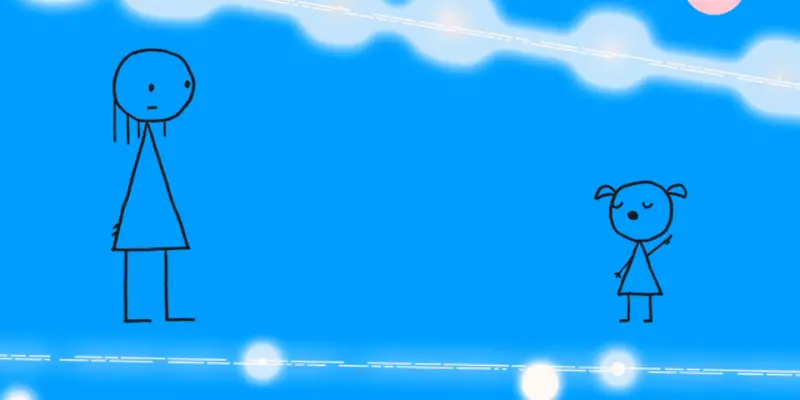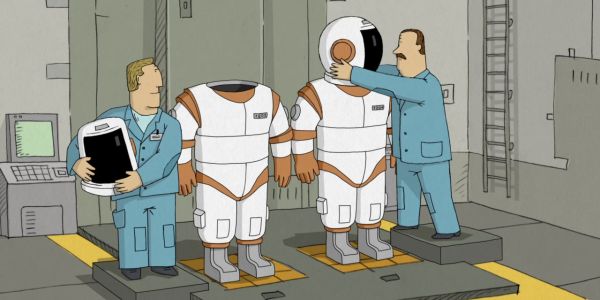2016 Oscar Nominated Animated Short Films: On Sad Bears, Cosmonauts and Hindu Superheroes

Jay is just a dude who takes in an unhealthy…
It is always nice to visit the short films that people work so hard on but you never really think about viewing. It is not until the Oscars that these films get any mainstream attention, and that is one of the best things the Oscars provides to filmmakers.
This year’s nominees are strong, featuring sad bears, old men who desperately want hand-drawn animation to survive, clumsy cosmonauts, Hindu superheroes, and some brilliant sci-fi. Here is a look at all five nominees before the ceremony begins.
Bear Story

I don’t know what I was expecting when I started watching the Chilean Bear Story, but it certainly wasn’t a heavy reflection on the loss of the ones you love. In the film, a father bear carries around dolls of his lost wife and child, who were taken away by a circus. Time has passed, but it is clear that his emotional wounds have not fully healed. Even with this loss lingering over his head, he still needs to find a way to make a living. He does this via a mechanical diorama that he cranks up whenever a passerby drops a coin into his cup.
The diorama is brilliantly animated, with characters that have jerky, mechanical motions but still show strong emotion. If there is one complaint I have with the film, it is that once we enter the diorama, it plays like a television, not a mechanical box. Settings change via camera movements, not through gears or levers. But if everything had been realistically geared, there would have been no way they could have packed this much visual punch into the short sequence. It is film at its most basic: visuals and a score. With great animation and a xylophone and piano score that floats effortlessly between haunting and light.
It is an incredibly dark, affecting tale told in a modern day fairytale world. Bears wear hats and beg on street corners, and they also feel human emotions when they are faced with devastating loss. The only humans in the story are the ones who beat and capture the father bear’s wife and child. Humans can be animals, and we can cause pain to the world around us. The morality of zoos, aquariums, and circuses has become a popular topic of conversation since the release Blackfish in 2013, and Bear Story takes that message to the next level by equating animal life to human life by putting the bears in a human environment.
The film’s themes extend even further than that, which is remarkable for a film lasting only ten minutes. The beatings and the forcing apart of families is representative of the violent regime of Pinochet in 1970’s Chile. But it is important to remember that life moves on, just as history does. Bear Story reminds us that we need to be optimistic about the future while always remembering our past, the good and the bad.
Prologue

Prologue is a very boring ode to the dying art of 2D animation. It is that simple. At the very beginning of the film, we are treated to live-action pan of a graveyard of discarded pencils, both colored and leaden. It is immediately clear that director Richard Williams (a truly fantastic illustrator who has done plenty of brilliant work in the past) wants you to know how important it is that we keep hand-drawn animation alive. It might not be quite as important as he thinks it is, but I agree with the general conceit.
Once we are taken into the paper world, we witness a minimalist battle between four ancient Greek soldiers in graphic detail. The film may be the most artistically bold piece, with its photorealistic pencil drawings contrasted by bright streams of blood and shield insignias, but there is simply nothing to it. It shows what the medium can do visually, but it doesn’t even try to establish any real world themes. The best thing about it? It’s only five minutes long.
Sanjay’s Super Team

I’m sure Sanjay’s Super Team will receive a lot of praise for its depiction of Hindu themes, but the film’s execution leaves much to be desired. The semi-autobiographical tale from director Sanjay Patel depicts a young, superhero-obsessed Indian boy watching TV on the other side of the room from his father, who is trying to peacefully pray. The father tries brings the boy over in an effort to get him to appreciate the tranquility of prayer, but he is constantly distracted.
However, Sanjay is transported into a magical world when he accidentally rings a bell… for some reason that isn’t explained. He ends up in a temple (that looks eerily similar to the House of Black and White from Game of Thrones) facing off against a legendary Hindu monster. It is not until the Hindu gods arrive that he is able to escape the realm and return to real life. If not for a small moment of family sweetness at the end, it would have played exactly like the hollow cartoons that Sanjay was blaring before his excursion. It manages to transcend that, but just barely.
The animation is also rather lackluster, especially by Pixar’s standards. The big-headed humans are cute enough, but the depictions of the gods and the monster are oddly angular and rudimentary. The lighting in the film is inconsistent and a bit jarring. It shouldn’t win the Oscar, but, hey, it’s better than Lava.
We Can’t Live Without Cosmos

This is the most purposefully comedic of the bunch, but it takes a surreal, dark turn near the end. We Can’t Live Without Cosmos is the story of two lifelong best friends who have been training to become cosmonauts. They act fairly goofy and there are a few pratfalls along the way, but they become the top two candidates in their class. Unfortunately, only one of them is needed for the next launch. Nonetheless, the reserve astronaut wells up when his buddy is sent up to space and he flashes their favorite book, We Can’t Live Without Cosmos, to the camera inside the ship.
The animation looks like the type of low-budget stuff you would have seen on TV in the 90’s, but it is full of charm and it fits the broadness of its comedy. They get visual humor out of the rudimentary animation. It is not an obstacle to be overcome. As with many of these Oscar nominated animated shorts, there is no dialogue, and the ambient piano provides a calmness that can be found in space and incites contemplation of what lies beyond.
About two-thirds into the film, we are treated to a pretty devastating twist that transforms the narrative into a fever dream. The grief displayed is akin to Bear Story, and we feel for our cosmonaut the same way we did for the father bear. All the while, We Can’t Live Without Cosmos manages to bring the comedy. It is a well-made film that I may not remember as time moves on, but it is a breezy, pleasurable watch with a surprising amount of depth.
World of Tomorrow

World of Tomorrow has a running time of about 17 minutes. Once it was over, I sat on my sofa and thought about it for about 25, its grand thoughts racing through my head as quickly as the film’s characters travel through time and space. Science fiction is often the most poignant genre we have, and this film is the one of the better pieces of sci-fi in the last several years. The story revolves around an unassuming toddler and her third generation clone. Essentially, it is a road trip movie through time and space that speaks of love, loss, morality, and mortality in equal measure.
The memories of each clone generation are implanted into the next generation once the time comes. So a person can live forever, or at least their memories can. The Emily clone travels back in time to address “Emily Prime”, whose biggest problem to this point has been speaking in complete sentences and identifying colors. Clone Emily takes Emily Prime through three specific memories that encompass the human condition more adeptly than any feature film did in 2015. This is the only nominee in this category that revels in dialogue, and it is necessary when you are tackling themes this grand.
The first memory is of an art exhibit the clone remembers from when she was young (but older than Emily Prime). The exhibit was a braindead man stranded in a tube for the entirety of his life. That was it. Emily visited regularly, finding great beauty in his stillness, great fascination in his aging, and great sadness with his death. We are then transported to the moon, where Emily worked with solar-powered robots, who she programmed to fear darkness, as well as death. She jumps from one idea to another going on to explain that she fell in love with a rock and befriended an alien named Simon. Her life was fascinating, but she still felt emptiness and longing for something better.
She returned to Earth and fell in love with a clone of the man from the art exhibit, who is mildly disabled after generations of cloning. Thinking of him now is sad but, as she says, “I am very proud of my sadness. It means I am more alive.” This profound dialogue is offset by stick figure protagonist with a hypnotic shape-and color-shifting background, reminiscent of Kubrick’s visuals as Dave Bowman transcended to the next stage of evolution. The visuals wash over you like a steady psychedelic stream so that your eyes stay transfixed and your ears take in the message director Don Hertzfeldt (who has already won multiple Academy Awards) presents. It is a true achievement that needs to be seen by all, and also needs to bring home the trophy for Best Animated Short.
Have you seen these films? Which one did you like best? Which one do you think will win the Oscar?
Does content like this matter to you?
Become a Member and support film journalism. Unlock access to all of Film Inquiry`s great articles. Join a community of like-minded readers who are passionate about cinema - get access to our private members Network, give back to independent filmmakers, and more.
Jay is just a dude who takes in an unhealthy amount of media of all types. Currently living in Atlanta, Georgia, he firmly believes that all movie theaters should have leather recliners, you eat popcorn too loudly, and if you don't put that cellphone away in 2 seconds you will learn the definition of frontier justice.













